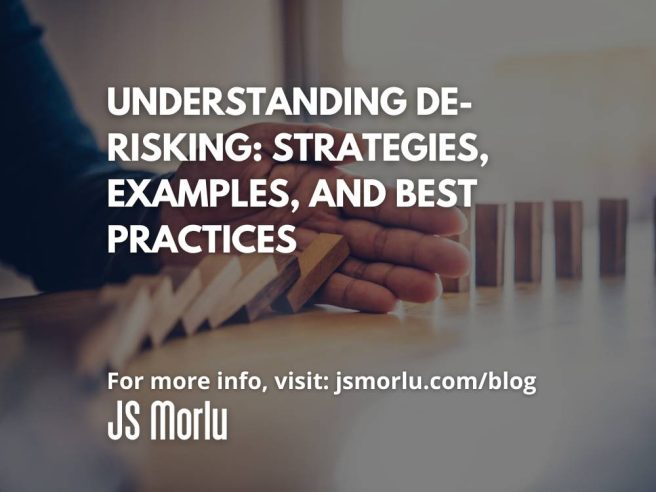By: John S. Morlu II, CPA
In today’s fast-paced, interconnected world, businesses are more exposed than ever to a wide array of risks—ranging from economic instability to cyber threats, regulatory changes, and geopolitical upheavals. De-risking, a systematic approach to identifying, managing, and mitigating these risks, has become an essential strategy for organizations aiming to safeguard their financial health, operational continuity, and reputation. Without a solid de-risking framework in place, even the most successful companies can face disruptions that threaten their long-term survival. For CEOs, government leaders, financial institutions, and multinational corporations alike, understanding and implementing effective de-risking strategies is no longer optional—it’s a business imperative.
The need for de-risking is not merely theoretical; it stems from real-world challenges that have the potential to derail businesses at any moment. Global supply chain disruptions, compliance with ever-evolving regulatory requirements, and the increasing threat of cyberattacks are just a few examples of risks that can have devastating consequences if left unchecked. Leaders must recognize that de-risking is about more than just reacting to crises; it’s about proactively identifying vulnerabilities and creating a robust framework to manage uncertainty. By taking a strategic, forward-thinking approach to risk, organizations can turn potential threats into opportunities for growth and innovation.
However, despite its growing importance, de-risking remains a misunderstood and underutilized tool among many business leaders. Often, organizations make the mistake of focusing solely on immediate risks, neglecting to take a comprehensive view of the threats that may impact their long-term objectives. This lack of understanding can lead to poor decision-making, missed opportunities, and in some cases, catastrophic business failures. This article aims to demystify the concept of de-risking, shedding light on the critical elements that organizations need to focus on to navigate the complexities of today’s global landscape successfully.
By breaking down the concept of de-risking, we will explore the core strategies for effective risk management and offer real-world examples to highlight both the successes and challenges of applying these strategies. Whether you’re leading a multinational corporation, a financial institution, or a government agency, the insights provided here will equip you with the knowledge needed to mitigate risks and ensure your organization’s resilience in an uncertain world. Read on to discover how de-risking can be your organization’s greatest asset in achieving sustainable success.

Chapter 1: What is De-risking?
De-risking is the proactive process of systematically identifying, managing, and reducing exposure to risks that can threaten an organization’s financial stability, operational efficiency, strategic goals, regulatory compliance, and reputation. It involves anticipating potential disruptions and implementing strategies to mitigate their impact before they materialize. These risks are not only varied in nature but can also have cascading effects across different areas of the business if left unchecked. As organizations operate in increasingly complex and interconnected environments, de-risking becomes essential for safeguarding long-term sustainability and resilience.
Financial risks are perhaps the most immediate and obvious concern. These risks encompass market volatility, currency fluctuations, credit defaults, and liquidity issues, all of which can erode profitability and destabilize business operations. For instance, the collapse of financial markets or currency depreciation can quickly turn a seemingly healthy balance sheet into a financial crisis. De-risking in this area requires companies to adopt robust financial risk management strategies such as diversifying investments, managing debt levels, and hedging against currency fluctuations.
Operational risks include failures within an organization’s internal processes, systems, or policies, often exacerbated by inadequate oversight or insufficient resources. For example, supply chain disruptions, production inefficiencies, or cybersecurity breaches can halt operations and lead to significant financial losses. By building more resilient systems and incorporating technologies that ensure business continuity—such as automation, cloud infrastructure, and enhanced security protocols—companies can mitigate these risks. Operational de-risking also involves implementing clear policies and training employees to handle potential breakdowns effectively.
Regulatory risks are an increasing concern for businesses that operate in multiple jurisdictions or highly regulated sectors like finance, healthcare, or energy. Changes in laws, industry standards, or compliance requirements can expose companies to significant penalties, legal disputes, or operational shutdowns. Cross-border operations, in particular, bring challenges such as navigating foreign regulations, anti-corruption laws, and trade restrictions. De-risking strategies in this domain involve staying ahead of regulatory changes through continuous compliance monitoring, developing strong relationships with legal advisors, and creating flexible operational frameworks that allow for rapid adaptation to new rules.
Finally, reputational risks have taken on a heightened significance in the digital age. Social media, online platforms, and 24-hour news cycles mean that negative public perception can spread rapidly, often with devastating consequences for a company’s brand and customer trust. A single misstep or scandal can tarnish an organization’s reputation and, by extension, its market value and revenue. De-risking reputational threats requires an organization to engage in consistent brand monitoring, maintain transparency in its operations, and quickly respond to emerging issues before they escalate. Public relations management and customer engagement are key tools in safeguarding an organization’s image.
The COVID-19 pandemic, geopolitical tensions, rising cyber threats, and environmental crises have all underscored the critical importance of de-risking strategies. These global challenges have exposed vulnerabilities in even the most robust organizations, highlighting the need for forward-thinking risk management approaches. De-risking is no longer a one-time exercise but an ongoing process that must be integrated into the core of an organization’s strategy to ensure resilience and long-term success in an increasingly unpredictable world.
Chapter 2: Why De-risking is Crucial for CEOs and Government Leaders
For CEOs and government leaders, the implementation of effective de-risking strategies is not just a matter of operational efficiency; it is fundamental to the survival and success of their organizations and public institutions. In today’s volatile environment, where risks are manifold and ever-evolving, proactive de-risking can be the difference between thriving and faltering. The stakes are high, and the consequences of inadequate risk management can be severe—ranging from financial distress and legal entanglements to reputational damage and operational paralysis. Ensuring that both private enterprises and public institutions are resilient to these risks is essential for maintaining stability and achieving long-term success.
Revenue Protection is a primary reason why de-risking is crucial. For CEOs, safeguarding revenue streams is vital to maintaining profitability and ensuring the organization’s financial health. Disruptions such as supply chain interruptions, sudden market shifts, or economic downturns can directly impact cash flow and profit margins. Effective de-risking strategies help to anticipate and mitigate these risks, enabling businesses to maintain stable revenue streams and avoid financial instability. By implementing comprehensive risk management frameworks, companies can better withstand market fluctuations and sustain their financial performance over time. For government leaders, ensuring financial stability is equally critical as they manage public funds and resources. Proper de-risking can prevent budgetary shortfalls and inefficiencies that could undermine public services and trust.
Compliance Assurance is another crucial benefit of de-risking, especially for organizations and government entities operating in heavily regulated industries. Failure to adhere to regulatory requirements can result in significant financial penalties, legal disputes, and damage to an organization’s credibility. For CEOs, this means avoiding costly fines and protecting the organization’s reputation. For government ministries, inadequate risk management can lead to misallocation of public resources, administrative inefficiencies, and political fallout. De-risking involves staying informed about evolving regulations, investing in compliance infrastructure, and conducting regular audits to ensure adherence. Prioritizing compliance allows both businesses and public institutions to avoid costly penalties, enhance operational integrity, and maintain public confidence.
Reputation Safeguarding is increasingly important in an age where public perception can be as impactful as financial performance. Reputational damage can erode customer trust, alienate stakeholders, and diminish competitive advantage. For CEOs, protecting the organization’s brand is essential for long-term success. Negative incidents, whether due to operational failures, ethical breaches, or poor customer service, can lead to a loss of market share and stakeholder support. Effective de-risking strategies include proactive public relations efforts, transparent communication, and rigorous crisis management plans to protect and enhance the organization’s reputation. For government leaders, safeguarding reputation is crucial for maintaining public trust and ensuring the effectiveness of governance. Transparency, accountability, and proactive management of potential crises help prevent reputational damage and foster a positive relationship with the public.
Sustainability is a broader and increasingly essential consideration in risk management. For both CEOs and government leaders, ensuring the long-term viability of their organizations and public institutions requires a focus on sustainability. This encompasses not only financial sustainability but also operational, environmental, and social dimensions. By incorporating de-risking strategies that address these aspects, organizations can build resilience against various threats and create a foundation for enduring success. This approach involves integrating sustainable practices, investing in future-ready technologies, and fostering a culture of continuous improvement. For CEOs, this means adopting practices that ensure long-term profitability while minimizing environmental impact. For government leaders, it involves creating policies that promote sustainable development and social equity, thereby ensuring the long-term prosperity and well-being of the public.
In summary, de-risking is crucial for CEOs and government leaders as it addresses the multifaceted challenges of revenue protection, compliance assurance, reputation safeguarding, and sustainability. By adopting proactive and strategic risk management approaches, leaders can safeguard their organizations from catastrophic outcomes and ensure they are well-positioned to navigate the complexities of today’s global landscape. The benefits of effective de-risking are not merely protective but also strategically advantageous, enabling both private enterprises and public institutions to thrive despite the uncertainties and challenges of the modern world.
Chapter 3: De-risking Strategies: Best Practices
In today’s complex and rapidly changing business environment, effective de-risking strategies are crucial for maintaining stability and achieving sustainable growth. The best practices for de-risking can vary widely depending on the industry and specific organizational needs. Below are six key strategies used by leading organizations to manage and mitigate risk effectively:
3.1 Diversification
Diversification involves spreading investments across different sectors, regions, or products to reduce exposure to any single risk factor. By diversifying, organizations can buffer themselves against market fluctuations, geopolitical tensions, and other disruptive events.
Example: Apple’s Supply Chain Diversification Apple provides a notable example of diversification in action. Previously reliant on China for a significant portion of its manufacturing, Apple has strategically expanded its production to India and Vietnam. This move reduces the company’s vulnerability to trade tensions between the U.S. and China and mitigates potential supply chain disruptions. By diversifying its production footprint, Apple ensures more stability in its supply chain and minimizes the impact of geopolitical and economic uncertainties.
3.2 Risk Transfer
Risk transfer involves shifting the burden of risk to third parties, often through mechanisms such as insurance, outsourcing, or financial hedging strategies. This approach helps organizations manage risks that are beyond their control by transferring them to entities better equipped to handle them.
Example: Airlines and Fuel Hedging A prime example of risk transfer is seen in the airline industry, where companies like Southwest Airlines use fuel hedging to manage the risk of fluctuating fuel prices. By locking in fuel prices through financial derivatives, these airlines stabilize their operational costs despite volatile oil markets. This strategy not only protects them from sudden price spikes but also allows for more predictable budgeting and financial planning.
3.3 Strengthening Governance and Compliance
Robust corporate governance and compliance frameworks are essential for adhering to legal and ethical standards, thereby reducing regulatory and reputational risks. Effective governance ensures that organizations operate within the bounds of the law and maintain high ethical standards, which can prevent costly legal issues and preserve organizational integrity.
Example: HSBC’s Anti-Money Laundering (AML) Compliance HSBC faced significant regulatory challenges due to deficiencies in its anti-money laundering (AML) practices. In response, the bank implemented a comprehensive de-risking strategy by tightening compliance measures and withdrawing from high-risk markets. This proactive approach not only mitigated the risk of future penalties but also reinforced HSBC’s commitment to regulatory compliance and ethical operations, helping to restore its reputation.
3.4 Implementing Technology and Automation
Leveraging technology and automation can significantly enhance efficiency and reduce human error in critical operations. Automation tools and artificial intelligence (AI) are increasingly being used to manage complex processes, improve accuracy, and bolster security.
Example: AI in Fraud Detection Banks such as JPMorgan Chase utilize AI to monitor transactions in real-time, which greatly enhances their ability to detect and prevent fraudulent activities. AI systems analyze vast amounts of data to identify unusual patterns and potential threats, allowing for swift intervention and reduced risk of financial loss. By incorporating advanced technology, these banks not only improve their security measures but also enhance their overall operational efficiency.
3.5 Building Strong Stakeholder Relationships
Establishing and maintaining robust relationships with stakeholders—including suppliers, customers, and regulators—helps organizations manage risks related to supply chain disruptions and regulatory changes. Strong stakeholder relationships facilitate better communication and collaboration, which can be crucial during times of crisis.
Example: Walmart’s Supplier Management Walmart’s approach to supplier management exemplifies how strong relationships can mitigate risk. The retail giant maintains close partnerships with its suppliers, which proved invaluable during the COVID-19 pandemic. By fostering open lines of communication and ensuring reliable supply chain practices, Walmart was able to navigate disruptions more effectively and maintain its operations during a challenging period.
3.6 Ethical Business Practices and Sustainability
Prioritizing ethics and sustainability not only builds trust with customers and investors but also helps reduce reputational and regulatory risks. Ethical business practices and a commitment to sustainability contribute to a positive public image and long-term organizational success.
Example: Patagonia’s Commitment to Sustainability Patagonia’s dedication to environmental sustainability is a prime example of how ethical practices can benefit a business. The company’s eco-friendly initiatives, such as using recycled materials and supporting environmental causes, have not only helped avoid reputational risks but also fostered a loyal customer base. Patagonia demonstrates that integrating sustainability into business operations can enhance brand reputation while driving profitability.
Chapter 4: The Role of Government in De-risking
Governments play a critical role in de-risking by leveraging their authority to implement regulations, offer guarantees, and facilitate public-private partnerships (PPPs). These interventions are essential for stabilizing industries, safeguarding businesses from systemic risks, and fostering a resilient economic environment conducive to sustainable growth and development.
4.1 Government-Led Financial De-risking
One of the primary mechanisms governments use to de-risk is the creation of robust regulatory frameworks aimed at preventing systemic risks and promoting financial stability. A key example is the Basel Accords, a set of international banking regulations developed by the Basel Committee on Banking Supervision. These regulations require financial institutions to adhere to strict capital adequacy, stress testing, and liquidity management standards, ensuring they are well-equipped to weather financial shocks. By implementing such rigorous standards, governments help fortify the global financial system, minimizing the risk of widespread economic crises.
In addition to banking regulations, governments also implement stabilization funds and insurance mechanisms designed to further protect financial markets. For instance, the Federal Deposit Insurance Corporation (FDIC) in the United States insures bank deposits, preventing bank runs and bolstering public confidence in financial institutions. By maintaining these safeguards, governments play a pivotal role in not only protecting individual investors but also in ensuring broader economic resilience.
4.2 Public-Private Partnerships (PPPs)
Public-private partnerships (PPPs) have emerged as a powerful tool for de-risking large-scale infrastructure projects, particularly in regions where such projects are critical to economic development. Through PPPs, governments and private enterprises collaborate to share financial, operational, and construction risks, thereby distributing the burden while maximizing the expertise and resources of both sectors.
The UK’s Crossrail Project is a prime example of a successful PPP, where the government and private contractors collaborated to manage risks associated with this multi-billion-dollar transportation project. This partnership allowed the project to benefit from the efficiency and technical expertise of the private sector, while the government provided oversight and financial support, ensuring that risks were mitigated across both parties.
Another significant example is the Senegambia Bridge, which connects The Gambia and Senegal. This infrastructure project was executed through a PPP, with both governments and private stakeholders sharing the financial investment and operational responsibilities. The collaboration greatly reduced the risk exposure for each party and facilitated the completion of a strategic regional link that boosts economic integration and trade within West Africa. In a further effort to de-risk and enhance the bridge’s operational efficiency, the government of The Gambia has entered into a Memorandum of Understanding with Africa50, a pan-African infrastructure investment platform. Under Africa50’s Asset Recycling Programme, the Senegambia Bridge will be monetized through a concession to the private sector, with the proceeds reinvested into other priority projects. This scheme ensures proper maintenance of the bridge and improves toll collection, while leading investors and capital providers work to secure financing for the government’s upfront capital needs.
Another notable example is the development of renewable energy projects, where governments often partner with private companies to deploy green technologies. These partnerships help mitigate risks related to investment, technology deployment, and regulatory compliance, driving the transition to sustainable energy while managing financial and operational uncertainties.
4.3 Government Guarantees and Support Mechanisms
In addition to regulations and PPPs, governments provide guarantees and support mechanisms to enhance de-risking efforts. These include credit guarantees for small and medium-sized enterprises (SMEs), which help mitigate the risk of loan defaults and encourage private sector lending. For instance, programs like the Small Business Administration (SBA) in the United States offer loan guarantees that reduce the risk for lenders, enabling SMEs to access essential capital.
Government support mechanisms also encompass emergency funds and bailouts during times of economic distress. Such measures, while often controversial, can provide critical liquidity and stability to sectors facing unprecedented challenges, thus preventing broader economic fallout.
In conclusion, governments play a pivotal role in de-risking through a multi-faceted approach involving regulations, public-private partnerships, and support mechanisms. Their actions help stabilize industries, protect businesses from systemic risks, and foster a more secure economic environment. By effectively managing risks and collaborating with private entities, governments can ensure a more resilient and sustainable economic future.
Chapter 5: The Consequences of Poor De-risking
Failing to implement effective de-risking strategies can lead to severe consequences, including financial crises, environmental disasters, and reputational damage. Historical examples illustrate the high stakes involved in inadequate risk management.
5.1 Lehman Brothers and the 2008 Financial Crisis
Lehman Brothers’ collapse, driven by excessive exposure to subprime mortgages, underscores the dangers of neglecting financial risks. The firm’s failure contributed to the 2008 financial crisis, highlighting the critical importance of sound risk management practices to prevent widespread economic turmoil.
5.2 BP’s Deepwater Horizon Spill
The Deepwater Horizon oil spill, resulting from BP’s insufficient safety measures, is a stark reminder of the catastrophic outcomes of poor risk management. The disaster not only led to massive financial penalties but also inflicted severe reputational damage on BP, demonstrating the far-reaching consequences of failing to address operational risks.
5.3 Boeing 737 Max Crisis
Boeing’s rush to develop the 737 Max without addressing critical design flaws resulted in two fatal crashes and significant damage to the company’s reputation and financial position. This crisis highlights the importance of thorough risk assessment and management in product development to prevent devastating outcomes.
Chapter 6: Balancing De-risking with Innovation and Growth
While de-risking is essential, it should not stifle innovation. Organizations must find a balance between managing risks and pursuing growth opportunities.
6.1 Risk-Aware Innovation
Forward-thinking companies, such as Google, exemplify how risk-aware innovation can drive success. Google encourages employees to explore experimental projects, fostering an environment where calculated risks are taken to achieve breakthroughs. Initiatives like Gmail, which emerged from an experimental project, showcase how managing risks effectively can lead to significant innovations and competitive advantages.
By integrating these best practices into their risk management strategies, organizations and government entities can enhance their resilience, safeguard their operations, and position themselves for long-term success in a complex and ever-changing global landscape.
Chapter 7: Conclusion-Embracing De-Risking: The Key to Stability and Sustainable Growth
De-risking is not merely a strategic option but a fundamental necessity for organizations committed to sustaining stability, safeguarding assets, and driving long-term growth. As the global landscape becomes increasingly complex and unpredictable, the ability to effectively manage and mitigate risks is crucial for both business leaders and government officials. By adopting best practices such as diversification, risk transfer, technological innovation, and strong stakeholder relationships, organizations can fortify their defenses against a myriad of potential threats.
The lessons drawn from past failures underscore the profound impact of inadequate risk management, reminding us of the importance of proactive, strategic approaches. Successful de-risking goes beyond mere survival—it enables organizations to thrive amidst uncertainty, adapt to evolving challenges, and seize new opportunities with confidence.
In today’s volatile environment, the integration of these de-risking strategies empowers leaders to navigate complexities with greater resilience and foresight. Prioritizing de-risking is not just about protecting what is at stake; it is about positioning for future success and ensuring that organizations and public institutions are well-equipped to face whatever lies ahead. Embracing these practices today lays the groundwork for a more secure, innovative, and prosperous tomorrow.
JS Morlu LLC is a top-tier accounting firm based in Woodbridge, Virginia, with a team of highly experienced and qualified CPAs and business advisors. We are dedicated to providing comprehensive accounting, tax, and business advisory services to clients throughout the Washington, D.C. Metro Area and the surrounding regions. With over a decade of experience, we have cultivated a deep understanding of our clients’ needs and aspirations. We recognize that our clients seek more than just value-added accounting services; they seek a trusted partner who can guide them towards achieving their business goals and personal financial well-being.
Talk to us || What our clients says about us







